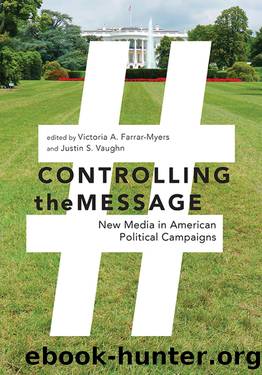Controlling the Message: New Media in American Political Campaigns by Victoria A. Farrar-Myers & Justin S. Vaughn

Author:Victoria A. Farrar-Myers & Justin S. Vaughn [Farrar-Myers, Victoria A. & Vaughn, Justin S.]
Language: eng
Format: epub
Tags: Political Science, Political Ideologies, Democracy, Political Process, General, Psychology, Psychopathology, Dissociative Identity Disorder, Social Science, Media Studies
ISBN: 9781479867592
Google: CZaIBwAAQBAJ
Goodreads: 24498747
Publisher: NYU Press
Published: 2015-03-27T07:45:30+00:00
Part 3
Social Mediaâs Impact on Campaign Politics
8
The Influence of User-Controlled Messages on Candidate Evaluations
JOSHUA HAWTHORNE AND BENJAMIN R. WARNER
The rise of social media as a potent political force in campaign politics played a major role in journalistic analyses of the 2012 presidential election. Traditional media lavished attention on the content of political discussions on social media platforms (Fouhy 2011; Sloan 2012), the influence of social media on electoral outcomes (Parker 2012), and the predictive power of social media trends on election results (âDid Social Media Predict the 2012 Presidential Election Results?â 2012). Driving this coverage was the fact that social media were more widely used during the 2012 election than at any previous time. For example, a picture of President Barack Obama hugging his wife, Michelle Obama, which was posted to commemorate his victory, became the most âlikedâ Facebook post ever (Willis 2012) and the most retweeted photo of all time (Parker 2012). Election night was the most live-tweeted event in U.S. history when considering the number of tweets posted (âElection Night 2012â 2012), closely followed by the first presidential debate (âDispatch from the Denver Debateâ 2012). Researchers at the Pew Internet and American Life Project determined that 39% of American adults used social media for political purposes during the 2012 election (Ranie et al. 2012). Given the wide use of social media in the 2012 election, no analysis of campaign messaging would be complete without examining the implications of these new communication platforms.
The wide use of social media in the 2012 campaign is significant because, perhaps more than any other technological innovation in electoral politics, Facebook and Twitter allow the user to control the message. Facebook users are not only authors of their own political content when they post status updates and comment on the updates of their friends; they are also gatekeepers of information when they manage their friend lists, hide posts from their feed, and distribute links to articles and videos to their own friends. Similarly, Twitter allows users to be the authors of their own brief messages, to distribute links to other campaign messages, and to select the sources they would like to receive information from in their own Twitter stream. Relative to other (especially traditional) modes of campaign communication, these social media platforms provide the greatest amount of control to individual users.
Though individual users in social media environments dominate message control, research has yet to demonstrate what effect, if any, social media communication has on attitudes toward candidates. More specifically, does social media communication influence how candidates are perceived? This is the central question addressed by the research presented here. In this chapter, we evaluate the relationship between social media communication about specific political events and perception of candidates by conducting two case studies from the 2012 election: one examining social media communication about the first presidential debate and one examining Governor Mitt Romneyâs leaked comments about the 47% of Americans whom he identified as not paying income tax.
Download
This site does not store any files on its server. We only index and link to content provided by other sites. Please contact the content providers to delete copyright contents if any and email us, we'll remove relevant links or contents immediately.
Whiskies Galore by Ian Buxton(41863)
Introduction to Aircraft Design (Cambridge Aerospace Series) by John P. Fielding(33064)
Small Unmanned Fixed-wing Aircraft Design by Andrew J. Keane Andras Sobester James P. Scanlan & András Sóbester & James P. Scanlan(32743)
Craft Beer for the Homebrewer by Michael Agnew(18140)
Turbulence by E. J. Noyes(7934)
The Complete Stick Figure Physics Tutorials by Allen Sarah(7307)
Kaplan MCAT General Chemistry Review by Kaplan(6865)
The Thirst by Nesbo Jo(6825)
Bad Blood by John Carreyrou(6542)
Modelling of Convective Heat and Mass Transfer in Rotating Flows by Igor V. Shevchuk(6391)
Learning SQL by Alan Beaulieu(6208)
Weapons of Math Destruction by Cathy O'Neil(6138)
Man-made Catastrophes and Risk Information Concealment by Dmitry Chernov & Didier Sornette(5920)
Digital Minimalism by Cal Newport;(5661)
Life 3.0: Being Human in the Age of Artificial Intelligence by Tegmark Max(5472)
iGen by Jean M. Twenge(5365)
Secrets of Antigravity Propulsion: Tesla, UFOs, and Classified Aerospace Technology by Ph.D. Paul A. Laviolette(5309)
Design of Trajectory Optimization Approach for Space Maneuver Vehicle Skip Entry Problems by Runqi Chai & Al Savvaris & Antonios Tsourdos & Senchun Chai(5011)
Electronic Devices & Circuits by Jacob Millman & Christos C. Halkias(4906)
